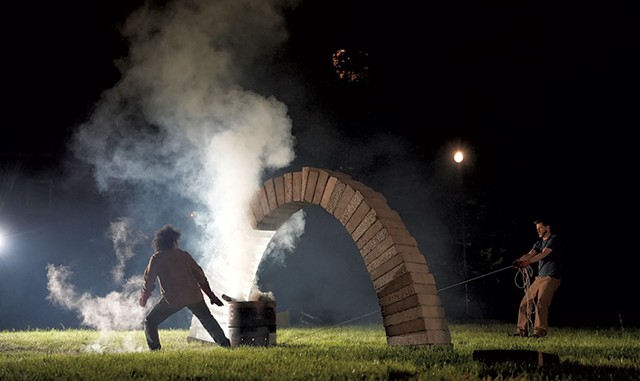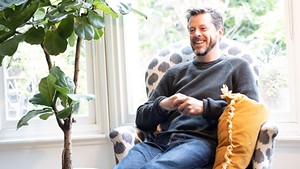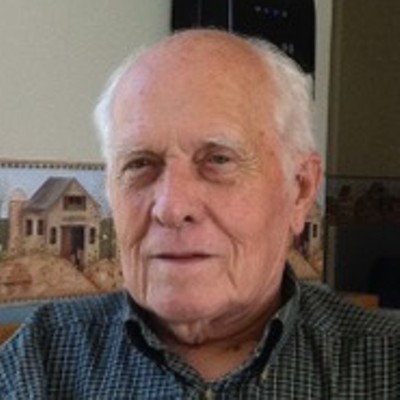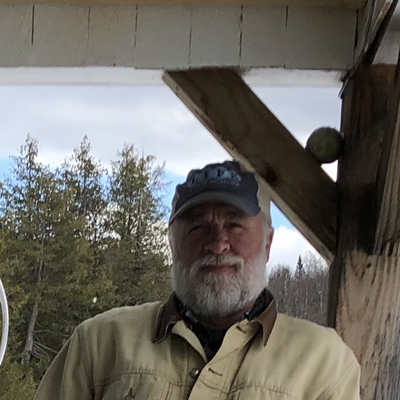
- Courtesy
- Arch
Watching ice melt might not be your go-to for an emotional or artistic experience. But audiences of Arch, a production coming to Burlington's Flynn this fall, may find the thawing process to be unexpectedly profound.
Arch is a production of Kaleider Studios in Exeter, UK, which creates unconventional artwork that often incorporates audience participation. The roughly two-hour show will have its U.S. premiere at the Flynn on Sunday, October 6, followed by the Flynn's first-ever mountaintop performance on Mount Philo on Friday, October 11.
In Arch, two performers construct an arch on a wooden former (or temporary structure) using 45 blocks, 30 of which are concrete and 15 of which are ice. The wooden former is removed, revealing a freestanding arch. Audience members then watch as the structure slowly melts over a fire — culminating in a dramatic collapse.
A chorus of community members will provide musical accompaniment for both the construction and collapse of the arch. Volunteers will participate in a three-hour rehearsal led by musical director and composer Verity Standen and then be planted in the audience as "secret singers" during the performance.
Depending on one's perspective, the arch's destruction could be symbolic of death, renewal, climate change or the fragility of institutions, according to Seth Honnor, Kaleider's artistic director.
"There's this kind of loss that is inevitable, because you know what's going to happen when the arch falls over," Honnor said. "Even though we tell people what is going to happen, people are quite surprised at how emotional their response is to it."
The idea for Arch came to Honnor in 2017, as he described the jolt he'd experienced after accidentally taking an extra step on the stairs and feeling the emptiness beneath his foot. In other words, a structure he'd assumed would be there was missing. Similarly, he suggested, humans have long believed we could rely on fossil fuels, only to learn that doing so isn't sustainable. Arch was the outcome of his attempt to channel these feelings into art.
Because of engineering and logistical challenges, seven years of research and development went into the production. For the arch to stand on its own, each block must be cut with no more than a two-millimeter margin of error. A freezer van transports the ice blocks, and performers use fire extinguishers filled with compressed carbon dioxide to keep them cool during the arch's construction.
Arch premiered in France in May. The production is currently touring Europe before it comes to the Flynn. Since shipping ice abroad is impractical, Kaleider will work with a local supplier to build the ice blocks and deliver them to the sites.
The speed at which the arch melts varies, subject to weather. Once or twice, Honnor said, the arch melted so slowly that audience members left before it fell. Anticipating when the arch will fall is part of the show, Honnor said.
"It's about humans and our habitual behaviors of building things that we then break, or building things that necessarily break," he said. "You see the builders of this arch also instigate the fall of it. And that is quite shocking, I think, for the audience."
Flynn executive director Jay Wahl said he found the show an ideal fit for Vermont as the state grapples with the effects of climate change — specifically, the recent floods. He connected with Honnor through IN SITU, a network of organizations that create art in public spaces; the Flynn is the only non-European member.
Among the shows Kaleider has already produced at the Flynn was the September 2022 social experiment The Money, in which ticket purchases went toward a pot of cash that a group of strangers had one hour to decide unanimously how to spend. Honnor also facilitated the Flynn's three-day public meeting in January to help shape chart its future.
While Arch is certainly unique, Wahl sees the fleeting nature of the creation as emblematic of performance in general.
"We engage in time-based artwork," he said of the Flynn. "We don't build brass statues that tend to stay there forever, right? We build things that are ephemeral, and we have the experience together in time."
Arch will leave some tangible traces, though. In the end, the once-standing structure will be reduced to debris and puddles.







Comments
Comments are closed.
From 2014-2020, Seven Days allowed readers to comment on all stories posted on our website. While we've appreciated the suggestions and insights, right now Seven Days is prioritizing our core mission — producing high-quality, responsible local journalism — over moderating online debates between readers.
To criticize, correct or praise our reporting, please send us a letter to the editor or send us a tip. We’ll check it out and report the results.
Online comments may return when we have better tech tools for managing them. Thanks for reading.